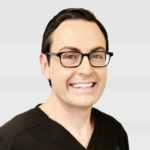Septoplasty is the surgical modification of the structure of the nasal septum. The septum is a midline structure, composed of bone and cartilage, that divides the nose into a right and left compartment and plays a crucial role in nasal structure and function. It helps to define the tip of the nose, supports the middle part of the nose, and also contains some sensory tissue that allows us to smell.
External nasal trauma – even when the nose is not broken – is the most common cause of septal injury and later deformity. Most people do not seek medical attention after minor nasal trauma, and the injured septum heals in a crooked manner and obstructs the nasal passages. In extreme cases, patients may develop a septal hematoma (collection of blood within the septum). This can cause lifelong issues with nasal structure and function, and if untreated may result in the collapse of the middle part of the nose (saddle nose deformity). Any suspicion of septal hematoma requires urgent medical attention. For other patients, no obvious cause is found for their deviated septum (they were “born with it”).
Explore our
Patient Gallery
*Actual patients in photos

Septoplasty may be performed along with or as a component of a functional rhinoplasty. This is a nasal surgery that is designed to correct a specific anatomic issue and improve the nasal airway (breathing). This procedure is generally performed “open” (using an external incision); please see the procedure page for open rhinoplasty. As a nose specialist, Dr. Ransom offers his patients a unique ability to address both the internal and external parts of the nose. Functional rhinoplasty, however, is not a cosmetic surgery.
Recovery from septoplasty is not difficult, though the nose may feel “stuffy” for a few days. Topical medications can be used, after the initial healing, to decrease this symptom. Dr. Ransom does not use any nasal packing, which allows the patient to breath normally more quickly after the surgery and significantly reduces postoperative discomfort.
Who is a candidate?
Patients with significant breathing problems, snoring, and nasal obstruction which are derived from a crooked or fractured nasal septum are candidates for septoplasty. Most patients have a history of nasal trauma, either recent or remote, and experience ongoing issues with breathing, snoring, or recurrent sinus infections. Dr. Ransom will assess your nasal structure and function during your consultation and is happy to discuss the details of all types of nasal surgery.
Frequently Asked Questions
Please note that all patients are different and individual healing times and results may vary. The statements regarding procedures and recovery made here are general rules.
No packing is used in the nose, which makes recovery much more comfortable. Occasionally, patients with poor septal structure or severe fractures will require Silastic splints. These are kept in the nose for about ten days, to help the septum heal straight, and do NOT affect breathing. Your nose may feel “stuffy” for a few days, but this resolves quickly. Pain is minimal. You will likely feel tired for a couple days and should limit your activities and concentrate on resting and recovery. Contact sports, racket and ball sports, heavy lifting, and straining must be avoided until Dr. Ransom gives you the “okay” – this is typically two or three weeks.
For most patients, the initial recovery is quick – typically a few days to a week. Due to swelling inside the nose, many patients feel “stuffed up” for a few days. Occasional spotting is normal, but heavy bleeding should be reported to the doctor. Pain is minimal and Dr. Ransom does not use nasal packing, making recovery more comfortable for his patients. Functional improvements are typically seen after the internal swelling resolves, generally within a couple weeks of the procedure.
Dr. Evan Ransom is an Ivy League-educated and Ivy League trained Facial Plastic and Reconstructive Surgeon. He is a Double Board Certified Head and Neck Surgeon and Facial Plastic and Reconstructive Surgery and fellowship-trained in facial plastic, reconstructive, and laser surgery. His practice is in the San Francisco Bay Area, serving patients from San Francisco, Oakland, Marin County, Palo Alto, Silicon Valley, Walnut Creek, the East Bay, and all over Northern California.
 (415) 550-1077
(415) 550-1077 San Francisco
San Francisco




